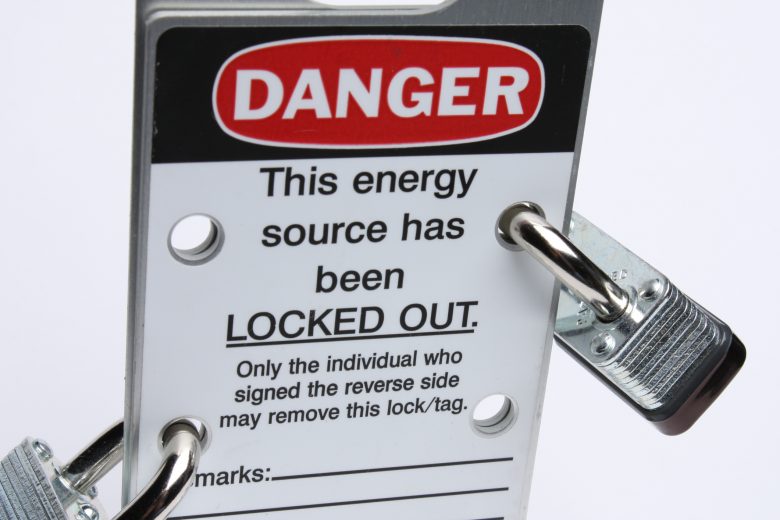The basic premise of lockout/tagout (LOTO) is simple: ensure equipment, machinery or vehicles are safe to service or perform maintenance on by locking energy-isolating devices on them (or attaching tags if locking is impossible). The goal is to ensure authorized employees can complete their work without fear of a machine starting (or being started) while they’re in harm’s way.
The responsibilities of employers include planning and setting up training for safe LOTO procedures. Companies also need to consistently monitor workers to ensure best practices for lockout/tagout are being followed, including conducting spot inspections and yearly audits, commonly referred to as periodic inspections. Energy control procedures should include the following principles:
- Notify workers in the area that LOTO procedures will be taking place. These workers are required to listen to instructions given by the worker performing LOTO procedures.
- Use appropriate locks or tags for the job. Locks and tags that are designated for servicing and maintenance shouldn’t be used for anything else as this can undermine their importance and no longer identifies the hazards they are meant to demarcate.
- Locks and tags must be marked with the names (or even photos) of the workers authorized to use them. Never use other people’s locks and never attach or remove a lock on behalf of someone else.
- Don’t use duplicate keys (unless your company has a safety professional who acts as a LOTO administrator). Only the worker placing the lock should have the key to open it.
- If more than one employee is working on the machine, every person has to attach their own lock to a hasp at each isolation point. The machine cannot be restarted until each employee has removed their lock or tag.
- Large or complex pieces of equipment with many hazardous energy sources, and thus requiring many people to work on it simultaneously, should allow for a group lockbox. This means that instead of dozens of locks on a machine, each lockout point is secured with a single padlock. Keys to these locks are placed in the group lockout box, which is locked by each employee affixing their personal lock. The employees then remove their personal lock from the lockbox once the work is finished, freeing the keys inside. Using a group lockout box reduces the number of locks required on a job and provides a quick overview of who is still working without having to check each energy point.
- Locks and tags should be strong enough to prevent accidental removal. They should also be strong enough to require excessive force or tools to remove them.
- Remember to check for and lock out secondary sources of hazardous energy. After all, LOTO requirements don’t only apply to electrical energy sources. For example, hydraulic, pneumatic and chemical energy sources should be relieved. There are also spring-loaded machines that can cause injury despite the electrical switch being turned off. And people sometimes forget that gravity itself can be a killer, which is why it’s important to block pieces of equipment that can fall on someone working below.
- Hazardous energy lockout verification is an important step in the LOTO procedure. Always try to start the machine using the controls. Also, check that all the locks and tags are where they should be and ensure that secondary sources of energy are also locked.
- If there is more than one person working on a machine, each one of them should verify the lockout.
- Remove locks or tags once the work is completed. There should be procedures in place to deal with shift changeovers that occur in the middle of servicing equipment that is locked/tagged out.
- Return the equipment to proper operation and ensure correct functioning.
- Notify workers in the area that LOTO-related work has been completed.
Despite the importance of lockout/tagout as a life-saving practice, there are still numerous violations of LOTO procedures each year. In fact, lockout/tagout has the dubious honor of holding a long-standing spot on OSHA’s top ten cited violations.
Consistent application of the lockout/tagout process can be a struggle for many reasons. Workers may not have a clear picture of the best practices outlined above. There may not be adequate refresher training or inspections of energy control procedures on equipment. And employers may not take the necessary steps to combat issues that can affect compliance with LOTO regulations.
Factors like tiredness, rushing and cutting corners can undo all the best intentions in the world. And complacency can always lull workers into ignoring proper lockout/tagout procedures. This is why it’s so important to address employees’ ability to recognize decision-influencing states of mind by providing human error safety training.
It’s also essential for companies to provide regular oversight in order to catch and correct LOTO violations and to encourage workers to take the time required to follow LOTO best practices. Because after all, no job is so important that it’s worth risking someone’s life to finish.

